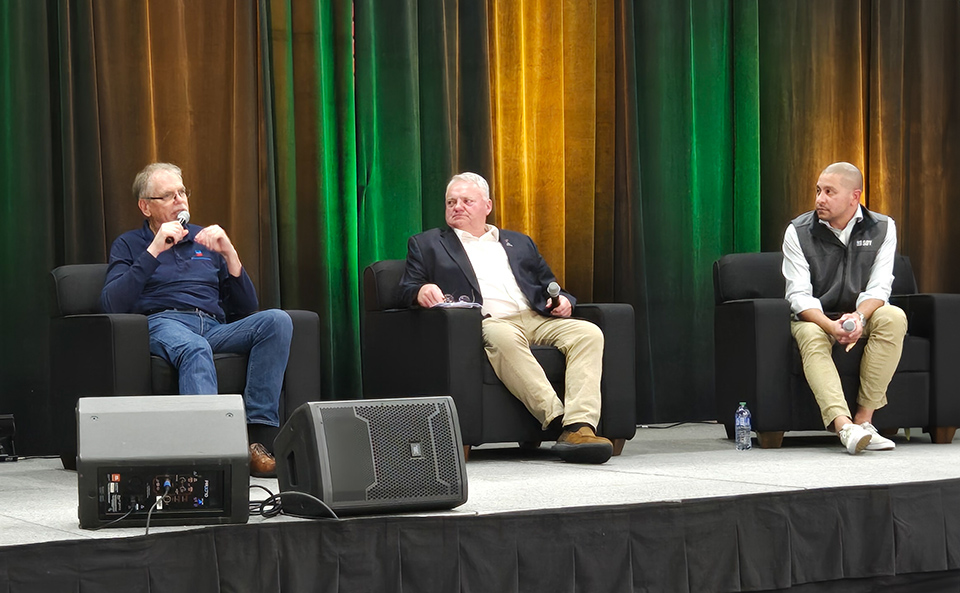
(Photo: Iowa Soybean Association / Kriss Nelson)
The Whole Bean: How U.S. Soy helps feed and fuel the world
March 7, 2024 | Kriss Nelson
Dubbed “America’s largest farmer-led, farmer-focused agricultural and educational experience,” this year’s Commodity Classic, held last week in Houston, emphasized education, with dozens of sessions available to attendees daily.
During a Q&A session held on the main stage, Mac Marshall, United Soybean Board (USB) vice president of market intelligence, served as moderator. He led discussions about how soybeans provide protein, oil and fiber that power the planet.
The panel comprised Wes Hays, product management lead for North American Soy for Bayer Crop Science, Kevin Lucke, president of Chevron Renewable Energy Group and Lawrence Sukaiski, USB director and farmer-leader from Minnesota.
Marshall: What is Bayer working on to help advance soy in terms of genetics or other solutions being brought to farmers to help produce a bountiful crop that produces protein and helps feed and fuel the world?
Hays: “There are a number of ways we are doing that (driving genetic gain) in soybeans, whether that is bringing yield, agronomics or biotech traits that bring herbicide tolerance, allowing us to control weeds. We are getting ready to launch our fourth generation of herbicide-tolerant traits, which brings five tolerances of herbicides to farmers as a tool in their toolbox, helping to drive yield for farmers. We are also looking at other ways to increase or enhance the profile of the soybean to make them more valuable.”
Marshall: What are some things exciting to you from a farmer's standpoint?
Sukaiski : Thanks to the checkoff, through a lot of research, education, and promotion and continued testing through the Clean Fuels Alliance America, there is a growing chance for soybeans to be a part of sustainable aviation fuel and renewable diesel. Agriculture needs a shot in the arm, and I think this is that shot. This is our chance, and I hope everyone gets behind it, supports it, and helps make agriculture more successful.
Marshall: We hear a lot about the potential growth in the renewable diesel and SAF market; what about the feedstocks that will be needed to supply that growth?
Lucke: All of us in the value chain need to continue impressing rule makers to get the policy framework set, and then you have to think of feedstocks. “When looking at the productivity of the U.S. farmer over the last 40 years, soybean yields have doubled, and they will continue to grow with better genetics. We are counting on that. We are looking at other feedstocks, such as CoverCress, camelina and winter canola. We are working with farmers, largely in the southern part of the U.S., to grow winter canola, replacing winter wheat, and have invested in a company in Argentina that produces camelina. The camelina seed has a high oil content. But for us to be successful in SAF, marine, biodiesel, or renewable diesel, we will need more feedstocks, and that is where our focus has been and needs to be. We are counting on the farmer's productivity.
Marshall: What is CoverCress, and how does it fit into the entire system for corn and soybean farmers?
Note: In August 2022, Bayer expanded its investment in the sustainable, lower-carbon oilseed producer CoverCress, Inc. CoverCress is a harvestable, low-input winter oilseed crop.
Hays: CoverCress is a cousin to penny-cress and is used as a cover crop. In a normal Midwest cycle, we would plant corn, harvest the corn, and plant CoverCress, which grows and is harvested early in the spring before planting soybeans. This is a nice way to get three crops in two years. Some of our world competitors can do that fairly easily, and it would be great to have that opportunity here in the United States.
It’s a high-oil content crop, and as far as filling that need for renewable low carbon fuels, CoverCress can help do that and fits nice from a sustainability standpoint by sustaining the soil by having the cover crop growing.
Marshall: As you discuss policy, one headwind is the misperception that there is a choice between food and fuel. That is not a choice; you need both. How confident are you in the ability of the American farmer to provide the critical needs of food and fuel?
Sukaiski: The checkoff will be a big part of that with education, promotion, and research. Yields will continue to go up, and we will find more sustainable practices. There is no question in my mind that we will grow enough for both food and fuel.
Lucke: The world’s going to need more of what the U.S. farmer produces. The only way we are going to solve the food and fuel dilemma we have in this world is through partnerships between energy, ag, farmers, equipment makers and seed companies and that’s because it’s a daunting challenge we have in front of us.
Marshall: When considering the next generation of fuels and the bioeconomy further downstream, what can farmers do to play a greater role in producing things that go beyond the farm?
Lucke: We have invested in 60 dairy digestors across the United States and are focused on renewable natural gas, which gets compressed into engines. Companies like Walmart and others are looking to lower greenhouse gas emissions for their fleets and are interested in us working in that space. Anything that provides lower-carbon fuels is what we need to explore.
We will need electricity in the future, but the infrastructure is not there yet. Hydrogen is the same story. It is going to take all the different forms of energy we can find.
Back